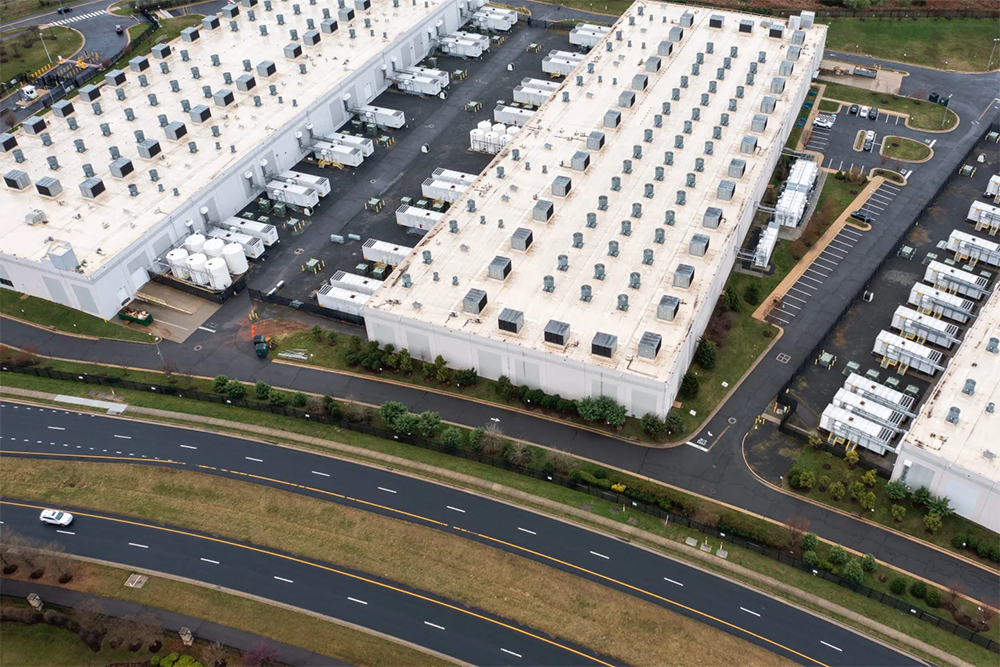如果你使用生成式人工智能,就會知道它看起來很神奇,。只需要動動手指,聊天機器人和多媒體模型就能夠毫不費力地創(chuàng)作出詩歌或者高清視頻,。
但人工智能模型的快速輸出和流暢界面掩蓋了為其提供支持的大量物理基礎(chǔ)設(shè)施,。隨著人工智能的不斷發(fā)展,其所依托的數(shù)據(jù)中心和發(fā)電廠開始受到行業(yè)外的廣泛關(guān)注,。
上周早些時候,我乘火車前往美國紐約州奧蘭治堡,,位于哈德遜河谷下游的一個冷清郊區(qū),,距離《財富》雜志位于曼哈頓市中心的新聞編輯部只有25英里(約40.23千米)。我在那里參觀了全美各地涌現(xiàn)的人工智能基礎(chǔ)設(shè)施項目之一——奧蘭治堡是數(shù)據(jù)中心公司DataBank的最新基地(名為LGA3)的所在地,。
DataBank已經(jīng)在紐約大都會區(qū)運營著兩個數(shù)據(jù)中心:一個位于新澤西州紐瓦克,另一個位于曼哈頓切爾西,。但LGA3數(shù)據(jù)中心將是迄今為止最大的數(shù)據(jù)中心,該設(shè)施耗資2.5億美元,,占地20萬平方英尺(約18,580.608平方米),,可以提供高達45兆瓦的能源,為五個裝滿計算機芯片的大型數(shù)據(jù)大廳提供動力,。
該設(shè)施明年才會啟用,,但租戶已經(jīng)開始預(yù)訂空間,其中最引人注目的是總部位于新澤西州的人工智能初創(chuàng)公司CoreWeave,。該公司最近獲得了令人瞠目的190億美元估值,,并已經(jīng)預(yù)訂了LGA3近一半的容量。
CoreWeave的創(chuàng)始人本·文圖羅在發(fā)給我的一份報告中寫道:“人工智能的爆炸式增長要求對傳統(tǒng)數(shù)據(jù)中心進行全面重新評估,,以滿足下一代計算需求,,而這一新數(shù)據(jù)中心園區(qū)提供部分最先進的新技術(shù),,使我們能夠為客戶提供服務(wù),。”
我乘坐的出租車從火車站出發(fā),,一路經(jīng)過農(nóng)舍和辦公園區(qū),,來到位于變電站和新澤西州州界之間的LGA3建筑工地,途中拐錯了不下四個彎,。下車后,,我的第一印象就是這座建筑規(guī)模宏大。LGA3看上去有一個紐約街區(qū)那么大,,巨大的單層大廳的天花板相當高——如果可以容納一架商用噴氣式飛機,,我也不會感到訝異。
“沉迷于技術(shù)”
DataBank的首席執(zhí)行官勞爾·馬丁內(nèi)克戴著一副透明邊框眼鏡,,身著淡紫色襯衫,,在入口迎接我的到來。他從事互聯(lián)網(wǎng)基礎(chǔ)設(shè)施行業(yè)已經(jīng)有數(shù)十年,,幾乎是從20世紀90年代商業(yè)互聯(lián)網(wǎng)出現(xiàn)開始,。自2017年以來,他一直在Databank工作,負責監(jiān)管該公司在美國和英國的69個數(shù)據(jù)中心,。他告訴我,,自20世紀90年代末互聯(lián)網(wǎng)泡沫以來,自己從未見過像人工智能這樣的數(shù)字基礎(chǔ)設(shè)施需求出現(xiàn)爆炸式增長,。
馬丁內(nèi)克對我說:“人類沉迷于技術(shù),,這一點毋庸置疑。最終,,對數(shù)據(jù)中心行業(yè)而言,,我們所做的就是讓人類能夠部署更多的技術(shù)。如果你部署更多的技術(shù),,就需要更多的光纖,、手機信號塔和數(shù)據(jù)中心。而對于人工智能所處的這一特定階段,,數(shù)據(jù)中心是瓶頸所在,。”

人工智能需求的大幅增長讓數(shù)據(jù)中心成為頭條新聞。馬丁內(nèi)克向我解釋道,,如今我們在網(wǎng)上完成的大多數(shù)事情——從瀏覽手機上的圖片到刷社交媒體平臺,,再到輸入ChatGPT提示語——涉及到的物理硬件比我們意識到的要多。Wi-Fi路由器和手機信號塔不斷通過地下光纜向數(shù)據(jù)中心和遠程服務(wù)器發(fā)送信號,,訪問存儲的信息,使互聯(lián)網(wǎng)持續(xù)運行,。
馬丁內(nèi)克說:“互聯(lián)網(wǎng)是網(wǎng)絡(luò),,對吧?信息通過光纖電纜以光子的形式發(fā)送出去,。它們以接近光速的速度在全世界進行傳輸,。昨晚我和一位從事網(wǎng)絡(luò)工作的人聚在一起,我問道:‘你是從事什么工作的,?’他回答道:‘我們是水管工,,對吧?’”
如今,,水管工是一個不錯的職業(yè),。在過去的20年里,互聯(lián)網(wǎng)產(chǎn)生的數(shù)據(jù)量呈指數(shù)級增長,,而且人們預(yù)期人工智能只會進一步加快發(fā)展速度,,這意味著存儲所有這些信息的空間需求量相當大。
馬丁內(nèi)克指著他的iPhone對我說:“2007年以前還沒有這種設(shè)備。想想看,,有多少內(nèi)容和應(yīng)用程序是[通過它]創(chuàng)造出來的,。所有這些內(nèi)容最終都會進入數(shù)據(jù)中心……這就是物理生態(tài)系統(tǒng)?!?/p>

人工智能提升了對建筑空間的需求
數(shù)據(jù)中心可能不是最熱門的項目,,但人工智能公司的需求激增帶來了大筆資金、大量媒體報道,,以及一些建筑界的巨頭,。自2016年以來,僅DataBank就在數(shù)據(jù)中心項目上花費了約45億美元,。建造LGA3的房地產(chǎn)公司美國鐵獅門(Tishman Speyer)是業(yè)內(nèi)知名度最高的公司之一:它曾經(jīng)參與世界貿(mào)易中心(World Trade Center)和芝加哥的約翰·漢考克中心(John Hancock Center)的建設(shè),,還擁有洛克菲勒中心(Rockefeller Center)。在郊區(qū)一個少年棒球聯(lián)盟棒球場旁邊建一座低矮的數(shù)據(jù)銀行,,對其投資組合來說似乎很奇特,,但該公司相信數(shù)據(jù)中心將被證明與摩天大樓一樣重要。
當我第一次收到參觀邀請時,,這個地點讓我大吃一驚,。位于紐約?全美國房地產(chǎn)和能源價格最高的地方,?在沙漠中建造數(shù)據(jù)銀行不是更省錢嗎,?那里地價更為便宜,而且可以獲得最低價的可再生能源,。
但馬丁內(nèi)克解釋道,,對許多客戶而言,把數(shù)據(jù)銀行建在距離業(yè)務(wù)最重要的部分之數(shù)千英里之外的地方是不現(xiàn)實的,。紐約是美國最大的數(shù)據(jù)中心市場之一,,目前在線容量約為800兆瓦,其中的大部分為金融和科技公司提供服務(wù),,這些公司依賴附近的算力進行全天候建設(shè)和交易,。
“將數(shù)據(jù)中心建在荒無人煙的地方是不現(xiàn)實的,原因是會出現(xiàn)太多延遲,?!瘪R丁內(nèi)克表示,他指的是計算機與異地數(shù)據(jù)中心之間的響應(yīng)時間延遲,?!皞鬏斖局锌赡軙l(fā)生太多事情?!?/p>
他繼續(xù)說:“數(shù)據(jù)中心傾向于集中在大都市地區(qū),。紐約一直是一個相當大的數(shù)據(jù)中心市場。這實際上是人口和企業(yè)的功能決定的——如果你是摩根大通(JPMorgan),就不會希望把數(shù)據(jù)中心設(shè)在奧馬哈,?!?/p>
公共政策也是一大因素。今年早些時候,,美國紐約州的州長凱西·霍楚爾公布了該州的“帝國人工智能計劃”,,該計劃專門撥出4億多美元,用于資助數(shù)據(jù)中心項目等基礎(chǔ)設(shè)施建設(shè),。
我戴上防護帽,,穿上反光背心,與兩名施工經(jīng)理一起繞著建成一半的建筑走了一圈,。他們指著飛機庫大小的區(qū)域說,,這里最終將安裝成排的計算機芯片,還有防止芯片過熱的通風和水冷設(shè)備,。
一旦建設(shè)完成,,CoreWeave和DataBank的其他客戶將開始安裝他們的芯片。DataBank預(yù)計該設(shè)施將在明年年初全面投入使用,。一旦上線,,CoreWeave將開始向科技初創(chuàng)公司和其他人工智能公司出租其算力。馬丁內(nèi)克告訴我,,DataBank在尋找客戶方面非常順利,。
“我們?nèi)ツ昱cCoreWeave簽訂了合同。當時這棟大樓甚至還不存在,,只是一片泥土,。這就展示了這一產(chǎn)品的受歡迎程度——達到了狂熱的地步?!?/p>
俗話說,,要趁熱打鐵。DataBank已經(jīng)在為隔壁的另一個地塊制定計劃:建成LGA4,。下次你開車在城里閑逛的時候,留意一下所在地區(qū)的那些不起眼的建筑:人工智能數(shù)據(jù)中心的盛況可能比想象的更近在眼前,。(財富中文網(wǎng))
譯者:中慧言-王芳
如果你使用生成式人工智能,,就會知道它看起來很神奇。只需要動動手指,,聊天機器人和多媒體模型就能夠毫不費力地創(chuàng)作出詩歌或者高清視頻,。
但人工智能模型的快速輸出和流暢界面掩蓋了為其提供支持的大量物理基礎(chǔ)設(shè)施。隨著人工智能的不斷發(fā)展,,其所依托的數(shù)據(jù)中心和發(fā)電廠開始受到行業(yè)外的廣泛關(guān)注,。
上周早些時候,我乘火車前往美國紐約州奧蘭治堡,位于哈德遜河谷下游的一個冷清郊區(qū),,距離《財富》雜志位于曼哈頓市中心的新聞編輯部只有25英里(約40.23千米),。我在那里參觀了全美各地涌現(xiàn)的人工智能基礎(chǔ)設(shè)施項目之一——奧蘭治堡是數(shù)據(jù)中心公司DataBank的最新基地(名為LGA3)的所在地。
DataBank已經(jīng)在紐約大都會區(qū)運營著兩個數(shù)據(jù)中心:一個位于新澤西州紐瓦克,,另一個位于曼哈頓切爾西,。但LGA3數(shù)據(jù)中心將是迄今為止最大的數(shù)據(jù)中心,該設(shè)施耗資2.5億美元,,占地20萬平方英尺(約18,580.608平方米),,可以提供高達45兆瓦的能源,為五個裝滿計算機芯片的大型數(shù)據(jù)大廳提供動力,。
該設(shè)施明年才會啟用,,但租戶已經(jīng)開始預(yù)訂空間,其中最引人注目的是總部位于新澤西州的人工智能初創(chuàng)公司CoreWeave,。該公司最近獲得了令人瞠目的190億美元估值,,并已經(jīng)預(yù)訂了LGA3近一半的容量。
CoreWeave的創(chuàng)始人本·文圖羅在發(fā)給我的一份報告中寫道:“人工智能的爆炸式增長要求對傳統(tǒng)數(shù)據(jù)中心進行全面重新評估,,以滿足下一代計算需求,,而這一新數(shù)據(jù)中心園區(qū)提供部分最先進的新技術(shù),使我們能夠為客戶提供服務(wù),?!?/p>
我乘坐的出租車從火車站出發(fā),一路經(jīng)過農(nóng)舍和辦公園區(qū),,來到位于變電站和新澤西州州界之間的LGA3建筑工地,,途中拐錯了不下四個彎。下車后,,我的第一印象就是這座建筑規(guī)模宏大,。LGA3看上去有一個紐約街區(qū)那么大,巨大的單層大廳的天花板相當高——如果可以容納一架商用噴氣式飛機,,我也不會感到訝異,。
“沉迷于技術(shù)”
DataBank的首席執(zhí)行官勞爾·馬丁內(nèi)克戴著一副透明邊框眼鏡,身著淡紫色襯衫,,在入口迎接我的到來,。他從事互聯(lián)網(wǎng)基礎(chǔ)設(shè)施行業(yè)已經(jīng)有數(shù)十年,幾乎是從20世紀90年代商業(yè)互聯(lián)網(wǎng)出現(xiàn)開始,。自2017年以來,,他一直在Databank工作,負責監(jiān)管該公司在美國和英國的69個數(shù)據(jù)中心,。他告訴我,,自20世紀90年代末互聯(lián)網(wǎng)泡沫以來,,自己從未見過像人工智能這樣的數(shù)字基礎(chǔ)設(shè)施需求出現(xiàn)爆炸式增長。
馬丁內(nèi)克對我說:“人類沉迷于技術(shù),,這一點毋庸置疑,。最終,對數(shù)據(jù)中心行業(yè)而言,,我們所做的就是讓人類能夠部署更多的技術(shù),。如果你部署更多的技術(shù),就需要更多的光纖,、手機信號塔和數(shù)據(jù)中心,。而對于人工智能所處的這一特定階段,數(shù)據(jù)中心是瓶頸所在,?!?/p>
人工智能需求的大幅增長讓數(shù)據(jù)中心成為頭條新聞。馬丁內(nèi)克向我解釋道,,如今我們在網(wǎng)上完成的大多數(shù)事情——從瀏覽手機上的圖片到刷社交媒體平臺,,再到輸入ChatGPT提示語——涉及到的物理硬件比我們意識到的要多。Wi-Fi路由器和手機信號塔不斷通過地下光纜向數(shù)據(jù)中心和遠程服務(wù)器發(fā)送信號,,訪問存儲的信息,,使互聯(lián)網(wǎng)持續(xù)運行。
馬丁內(nèi)克說:“互聯(lián)網(wǎng)是網(wǎng)絡(luò),,對吧,?信息通過光纖電纜以光子的形式發(fā)送出去。它們以接近光速的速度在全世界進行傳輸,。昨晚我和一位從事網(wǎng)絡(luò)工作的人聚在一起,,我問道:‘你是從事什么工作的?’他回答道:‘我們是水管工,,對吧,?’”
如今,水管工是一個不錯的職業(yè),。在過去的20年里,,互聯(lián)網(wǎng)產(chǎn)生的數(shù)據(jù)量呈指數(shù)級增長,而且人們預(yù)期人工智能只會進一步加快發(fā)展速度,,這意味著存儲所有這些信息的空間需求量相當大,。
馬丁內(nèi)克指著他的iPhone對我說:“2007年以前還沒有這種設(shè)備。想想看,,有多少內(nèi)容和應(yīng)用程序是[通過它]創(chuàng)造出來的,。所有這些內(nèi)容最終都會進入數(shù)據(jù)中心……這就是物理生態(tài)系統(tǒng),?!?/p>
人工智能提升了對建筑空間的需求
數(shù)據(jù)中心可能不是最熱門的項目,,但人工智能公司的需求激增帶來了大筆資金、大量媒體報道,,以及一些建筑界的巨頭,。自2016年以來,僅DataBank就在數(shù)據(jù)中心項目上花費了約45億美元,。建造LGA3的房地產(chǎn)公司美國鐵獅門(Tishman Speyer)是業(yè)內(nèi)知名度最高的公司之一:它曾經(jīng)參與世界貿(mào)易中心(World Trade Center)和芝加哥的約翰·漢考克中心(John Hancock Center)的建設(shè),,還擁有洛克菲勒中心(Rockefeller Center)。在郊區(qū)一個少年棒球聯(lián)盟棒球場旁邊建一座低矮的數(shù)據(jù)銀行,,對其投資組合來說似乎很奇特,,但該公司相信數(shù)據(jù)中心將被證明與摩天大樓一樣重要。
當我第一次收到參觀邀請時,,這個地點讓我大吃一驚,。位于紐約?全美國房地產(chǎn)和能源價格最高的地方,?在沙漠中建造數(shù)據(jù)銀行不是更省錢嗎,?那里地價更為便宜,而且可以獲得最低價的可再生能源,。
但馬丁內(nèi)克解釋道,,對許多客戶而言,把數(shù)據(jù)銀行建在距離業(yè)務(wù)最重要的部分之數(shù)千英里之外的地方是不現(xiàn)實的,。紐約是美國最大的數(shù)據(jù)中心市場之一,,目前在線容量約為800兆瓦,其中的大部分為金融和科技公司提供服務(wù),,這些公司依賴附近的算力進行全天候建設(shè)和交易,。
“將數(shù)據(jù)中心建在荒無人煙的地方是不現(xiàn)實的,原因是會出現(xiàn)太多延遲,?!瘪R丁內(nèi)克表示,他指的是計算機與異地數(shù)據(jù)中心之間的響應(yīng)時間延遲,?!皞鬏斖局锌赡軙l(fā)生太多事情?!?/p>
他繼續(xù)說:“數(shù)據(jù)中心傾向于集中在大都市地區(qū),。紐約一直是一個相當大的數(shù)據(jù)中心市場。這實際上是人口和企業(yè)的功能決定的——如果你是摩根大通(JPMorgan),,就不會希望把數(shù)據(jù)中心設(shè)在奧馬哈,。”
公共政策也是一大因素,。今年早些時候,,美國紐約州的州長凱西·霍楚爾公布了該州的“帝國人工智能計劃”,,該計劃專門撥出4億多美元,用于資助數(shù)據(jù)中心項目等基礎(chǔ)設(shè)施建設(shè),。
我戴上防護帽,,穿上反光背心,與兩名施工經(jīng)理一起繞著建成一半的建筑走了一圈,。他們指著飛機庫大小的區(qū)域說,,這里最終將安裝成排的計算機芯片,還有防止芯片過熱的通風和水冷設(shè)備,。
一旦建設(shè)完成,,CoreWeave和DataBank的其他客戶將開始安裝他們的芯片。DataBank預(yù)計該設(shè)施將在明年年初全面投入使用,。一旦上線,,CoreWeave將開始向科技初創(chuàng)公司和其他人工智能公司出租其算力。馬丁內(nèi)克告訴我,,DataBank在尋找客戶方面非常順利,。
“我們?nèi)ツ昱cCoreWeave簽訂了合同。當時這棟大樓甚至還不存在,,只是一片泥土,。這就展示了這一產(chǎn)品的受歡迎程度——達到了狂熱的地步?!?/p>
俗話說,,要趁熱打鐵。DataBank已經(jīng)在為隔壁的另一個地塊制定計劃:建成LGA4,。下次你開車在城里閑逛的時候,,留意一下所在地區(qū)的那些不起眼的建筑:人工智能數(shù)據(jù)中心的盛況可能比想象的更近在眼前。(財富中文網(wǎng))
譯者:中慧言-王芳
If you use generative AI, you know that it can seem like magic. Chatbots and multimedia models can effortlessly conjure up poems or high-res videos at the snap of a finger.
But AI models’ speedy outputs and sleek interfaces mask the enormous amount of physical infrastructure behind them—and as AI continues to grow, the data centers and power plants that AI is built on are starting to get widespread attention outside of the industry.
Earlier last week, I took a train to Orangeburg, New York, a sleepy lower Hudson Valley suburb just 25 miles from Fortune’s newsroom in downtown Manhattan. I was there to visit one of a wave of AI infrastructure projects popping up across the country—Orangeburg is the future home of data center company DataBank’s newest site, named LGA3.
DataBank already operates two data centers in the New York metro area: one in Newark, New Jersey, and one in Chelsea, Manhattan. But LGA3 will be by far its biggest site—a $250 million, 200,000-square-foot facility drawing up to 45 megawatts of energy to power five massive data halls packed to the gills with computer chips.
The facility won’t open until next year, but tenants have already been booking space—most notably New Jersey-based AI startup CoreWeave, which recently secured an eye-watering $19 billion valuation and has already reserved almost half of LGA3’s capacity.
“The explosive growth in artificial intelligence has required a complete reevaluation of traditional data centers to meet demand for next-generation compute requirements, and this new data center campus provides some of the most advanced new technologies that will allow us to deliver for our customers,” CoreWeave founder Ben Venturo wrote to me in a note.
My taxi from the train station took no less than four wrong turns as we wound our way past farmhouses and office parks to the LGA3 construction site, wedged between an electrical substation and the New Jersey state line. Hopping out of the car, my first impression was the sheer size of the building. LGA3 looked about the size of a New York city block, a massive, single-story hall with high ceilings—I wouldn’t be surprised if you could fit a commercial jet inside.
“Addicted to technology”
DataBank CEO Raul Martynek greeted me on the way in, wearing clear-rimmed glasses and a lavender button-down. Martynek has been in the internet infrastructure industry for decades, almost since the advent of the commercial internet in the 1990s. He’s been with Databank since 2017, overseeing the company’s 69 data centers across the U.S. and U.K. Martynek told me that he hasn’t seen an explosion in demand for digital infrastructure like the one AI is creating since the dot-com bubble of the late ’90s.
“Humans are addicted to technology, period. And ultimately, for the data center sector, what we do is we enable humans to deploy more technology,” Martynek told me. “If you deploy more technology, you need more fiber, more cell towers, more data centers. And for this particular phase that we’re in with AI, data centers are the bottleneck.”
A huge increase in demand from AI has catapulted data centers into front-page headlines. Martynek explained to me that most things we do online nowadays—from accessing images on our phones to scrolling social media to prompting ChatGPT—involve physical hardware more than we realize. Wi-Fi routers and cell towers are constantly sending signals through underground fiber optic cables to data centers and remote servers, accessing stored information and keeping the internet humming.
“The internet is a network, right? Information gets sent out over fiber optic cables as photons. And they travel around the world at close to the speed of light,” Martynek said. “I was hanging out with a network guy last night saying, ‘What do you do?’ He said, ‘We’re plumbers, right?’”
And these days, being a plumber is a good business. Exponential increases in the amount of data being generated for and by the internet over the past 20 years—and expectations that AI will only speed things up even more—mean that space to store all that information is in high demand.
“This device didn’t exist before 2007,” Martynek told me, pointing to his iPhone. “So think about how much content and how many applications have been created [by it.] All that stuff ends up in a data center…That’s the physical ecosystem.”
AI boosts need for building space
Data centers might not be the sexiest projects, but a surge in demand from AI companies is bringing in big money, heavy press coverage, and some of the biggest names in construction. DataBank alone has spent around $4.5 billion on data center projects since 2016. Tishman Speyer, the real estate company building LGA3, is one of the highest-profile names in the business: it worked on the World Trade Center and Chicago’s John Hancock Center, and it owns Rockefeller Center, too. A low-slung data bank next door to a suburban Little League baseball complex might seem an odd addition to its portfolio, but it’s betting that data centers will prove to be just as important as skyscrapers.
When I first got the invite to visit, the location surprised me. New York? Home to some of the highest real estate and energy prices in the country? Wouldn’t it be cheaper to build this in the middle of the desert, where land is cheaper and there’s access to bottom-dollar renewable energy?
But Martynek explained that for many customers, it’s just not practical to be located thousands of miles away from one of the most important parts of your business. New York is one of the country’s largest data center markets, with around 800 megawatts of capacity currently online, much of it catering to finance and tech companies who depend on nearby computing capacity to build and trade around the clock.
“It’s not practical for a data center to be in the middle of nowhere—there’s too much latency,” Martynek said, referring to delays in the response time between computers and offsite data centers. “Too many things can happen along the way.”
“Data centers have tended to cluster around metropolitan areas,” he continued. “New York has always been a pretty big data center market. That’s really a function of the population and a function of the businesses—if you’re JPMorgan, you don’t want your data center in Omaha.”
Public policy is also a factor. New York Governor Kathy Hochul unveiled the state’s Empire AI initiative earlier this year, which earmarked over $400 million to fund, among other things, infrastructure such as data center projects.
Donning a hard hat and reflective vest, I walked around the half-built structure with two construction managers. They pointed out the airplane hangar-sized area where the banks of computer chips would eventually be installed, along with the ventilation and water cooling to keep them from overheating.
Once construction is finished up, CoreWeave and DataBank’s other customers will start installing their chips, and DataBank expects the facility to be up and running in full by early next year. Once it’s online, CoreWeave will start leasing out its computing capacity to tech startups and other AI companies. Martynek told me DataBank hasn’t had any trouble finding customers.
“We signed the contract with CoreWeave last year. This building didn’t even exist then—it was just dirt. That’s how in-demand this product is,” Martynek said. “There’s a frenzy.”
As the saying goes, strike while the iron’s hot—DataBank is already putting together plans for another site right next door, LGA4. Next time you’re driving around town, keep an eye on the nondescript buildings in your area: The AI data center boom might be closer than you think.






